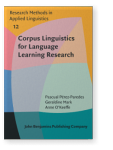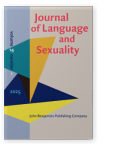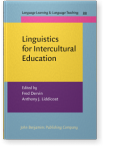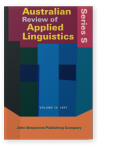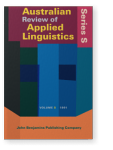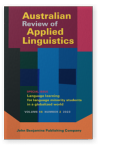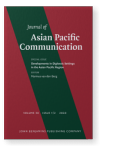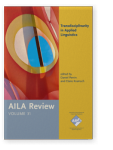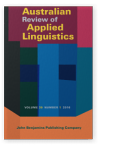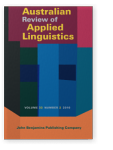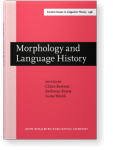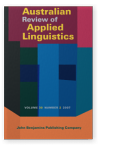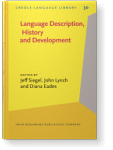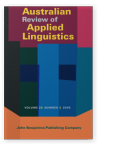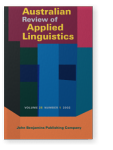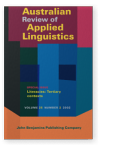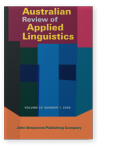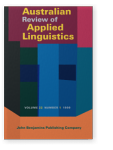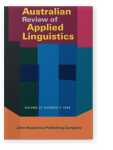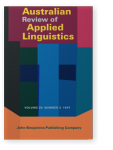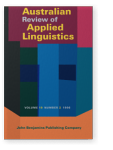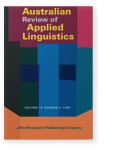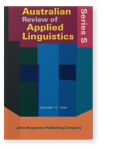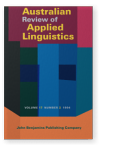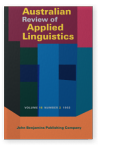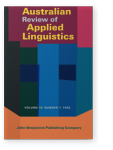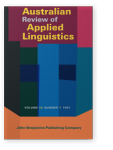Anthony J. Liddicoat
List of John Benjamins publications for which Anthony J. Liddicoat plays a role.
Book series
Journal
ISSN 2211-3770 | E-ISSN 2211-3789
Titles
Linguistics for Intercultural Education
Edited by Fred Dervin and Anthony J. Liddicoat
[Language Learning & Language Teaching, 33] 2013. vi, 201 pp.
Subjects Applied linguistics | Language acquisition | Language teaching
Teaching Languages, Teaching Culture
Edited by Anthony J. Liddicoat and Chantal Crozet
[Australian Review of Applied Linguistics. Series S, 14] 1997. iv, 146 pp.
Subjects Applied linguistics | Language acquisition | Language teaching
Language Planning and Language Policy in Australia
Edited by Anthony J. Liddicoat
[Australian Review of Applied Linguistics. Series S, 8] 1991. iv, 230 pp.
Subjects Applied linguistics | Language acquisition | Language teaching
2023 Reflections on language learning and social practice for language minority students Language learning for language minority students in a globalized world, Teng, Mark Feng and Fan Fang (eds.), pp. 279–288 | Commentary
2020 Dimensions of language education policy in Asia Developments in Diglossic Settings in the Asian Pacific Region, Berg, Marinus van den (ed.), pp. 7–33 | Article
This paper will identify the major trends that can be determined from an overall study of recent language policies across Asia. The trends can be seen across three interrelated themes, namely: the promotion and privileging of one language as the national language as part of an attempt to create a… read more
2018 Language teaching and learning as a transdisciplinary endeavour: Multilingualism and epistemological diversity Transdisciplinarity in Applied Linguistics, Perrin, Daniel and Claire Kramsch (eds.), pp. 14–28 | Article
Language teaching and learning is commonly considered as a research discipline that resides within the field of ‘applied linguistics’, at least in the way the field is conceptualized by English-speaking academia. However, if we consider language teaching and learning as practice, this fit is not… read more
2016 The trajectory of a language policy: The First Language Maintenance and Development program in South Australia Australian Review of Applied Linguistics 39:1, pp. 31–46 | Article
This paper examines the development of the First Language Maintenance and Development (FLMD) program in South Australia. This program is the main language policy activity that specifically focuses on language maintenance in government primary schools and has existed since 1986. During this time,… read more
2013 Introduction: Linguistics for intercultural education Linguistics for Intercultural Education, Dervin, Fred and Anthony J. Liddicoat (eds.), pp. 1–25 | Article
2010 Applied linguistics in its disciplinary context Australian Review of Applied Linguistics 33:2, pp. 14.1–14.17 | Article
Australia’s current attempt to develop a process to evaluate the quality of research (Excellence in Research for Australia – ERA) places a central emphasis on the disciplinary organisation of academic work. This disciplinary focus poses particular problems for Applied Linguistics in Australia. This… read more
2008 21. The morphological development of the perfect in Jersey Norman French Morphology and Language History: In honour of Harold Koch, Bowern, Claire, Bethwyn Evans and Luisa Miceli (eds.), pp. 299–312 | Article
2007 The Ideology of interculturality in Japanese language-in-education policy Australian Review of Applied Linguistics 30:2, pp. 20.1–20.16 | Article
Language learning is frequently justified as a vehicle for promoting intercultural communication and understanding, and language-in-education policies have increasingly come to reflect this preoccupation in their rhetoric. This paper will examine the ways in which concepts relating to… read more
2007 31. Language-in-education policy in the context of language death: Conflicts in policy and practice in Colombia Language Description, History and Development: Linguistic indulgence in memory of Terry Crowley, Siegel, Jeff, John Lynch and Diana Eades (eds.), pp. 419–430 | Article
2005 Culture for language learning in Australian language-in-education policy Australian Review of Applied Linguistics 28:2, pp. 28–43 | Article
Australia’s language-in-education policy documents have consistently included references to the place of ‘culture’ in language teaching. This paper seeks to examine how the major national policies conceptualise culture and interculturality in relation to languages education. For each policy, this… read more
2002 The development of comprehension in interlanguage pragmatics: The case of request strategies in English Australian Review of Applied Linguistics 25:1, pp. 19–39 | Article
In the past, research in interlanguage pragmatics has primarily explained the differences between native speakers’ (NS) and non-native speakers’ (NNS) pragmatic performance based on cross-cultural and linguistic differences. Very few researchers have considered learners’ pragmatic performance… read more
2002 The interaction of discipline and culture in academic writing Literacies: Tertiary contexts, Golebiowski, Zosia, pp. 59–71 | Article
Work in contrastive rhetoric has often sought to examine the impact of culturally-based writing conventions on text production and has outlined cultural differences in texts in different languages. At the same time, the study of specialised languages has often claimed a degree of uniformity in… read more
2000 Telephone openings in Samoan Australian Review of Applied Linguistics 23:1, pp. 95–107 | Article
Many studies of telephone interaction have concentrated on the opening sequences of telephone calls using the model developed by Schegloff (1968, 1979, 1986) using North American data as a starting point. This study uses this model as a starting point to examine telephone openings in Samoa. A… read more
1999 What makes partnership valid? Home-school communication and parent-school partnerships Australian Review of Applied Linguistics 22:1, pp. 43–60 | Article
Recent work in literacy has emphasised the partnership between parents and schools in furthering children’s literacy development. This paper discusses the nature of this partnership in late primary school and early secondary school learning in Australia and the ways in which information is… read more
1998 The structure of callers’ contributions in talkback radio Australian Review of Applied Linguistics 21:2, pp. 79–104 | Article
This paper examines the ways in which callers structure the message phase of their contributions in which they express a point of view and how expressing a POV in a talkback radio is realized through the interaction of caller and host, and in some cases between the caller, the host and an invited… read more
1997 Teaching culture as an itegrated part of language teaching: An introduction Teaching Languages, Teaching Culture, Liddicoat, Anthony J. and Chantal Crozet (eds.), pp. 1–22 | Article
1997 Everyday speech as culture: Implications for language teaching Teaching Languages, Teaching Culture, Liddicoat, Anthony J. and Chantal Crozet (eds.), pp. 55–70 | Article
1997 The role of language learning in academic education: An overview Australian Review of Applied Linguistics 20:2, pp. 19–32 | Article
Language learning has rarely had a secure place in perceptions of teriary education and is coming increasingly under threat as the result of tightening budgets in Australian Universities. This paper examines the role of language learning as a part of tertiary education. It argues that language… read more
1995 Review of Burke (1993): The art of conversation Australian Review of Applied Linguistics 18:2, pp. 175–180 | Review
1995 Argumentation as an interactional process in conversation Australian Review of Applied Linguistics 18:2, pp. 85–104 | Article
Argument is a structured phenomenon, the structuring of which is evident in conversational activity. This study begins with speech act analyses of argumentation and examines the was in which idealized models of argumentation relate to the linguistic behaviour of participants in argument as talk.… read more
1994 Closings in talkback radio: Institutional effects on conversational routines Spoken Interaction Studies in Australia, Gardner, Rod (ed.), pp. 21–46 | Article
This paper explores the effects of institutional communication on highly regular casual conversation routines. The institutional environment chosen is radio telephone conversation or talkback radio. Systematic variations from mundane telephone conversations were found in the closing sections and… read more
1994 Review of Ozolins (1993): The Politics of Language in Australia Australian Review of Applied Linguistics 17:2, pp. 190–197 | Review
1993 Choosing a liturgical language: Language policy and the Catholic mass Australian Review of Applied Linguistics 16:2, pp. 123–141 | Article
Religious language use in a multilingual community represents a special case of language planning. The choice of a liturgical language is determined both by religious and practical considerations and is based, in part, on the ways in which people view sacred activities. The Catholic Church has at… read more
1992 Review of Bell (1991): The Language of News Media Australian Review of Applied Linguistics 15:1, pp. 145–148 | Review
1991 The role of the national languages institute of Australia in the development and implementation of language policy in Australia Language Planning and Language Policy in Australia, Liddicoat, Anthony J. (ed.), pp. 64–76 | Article
The establishment of a languages institute has long been seen as an important step in the development of Australian language policy. After the adoption of the National Policy Languages, renewed impetus for a languages institute gave rise to the establishment of the National Languages Institute of… read more
1991 Reading picture books on television: Implications for the acquisition of literacy Australian Review of Applied Linguistics 14:1, pp. 91–111 | Article
Television plays a major role in the lives of children. This studies examines one aspect of children’s television – the reading of picture books. Interaction centred around picture books has been shown to be an important element in the acquisition of literacy. Mediated picture books and “live”… read more
1991 Editor’s foreword Language Planning and Language Policy in Australia, Liddicoat, Anthony J. (ed.), pp. 1–2 | Miscellaneous
